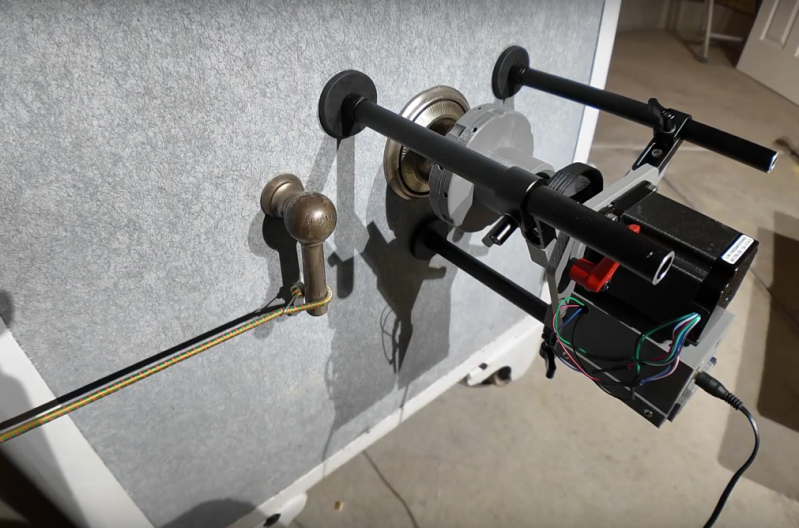When attempting to secure something, whether it’s a computer, sensitive data, or valuables, there’s always going to be a way to break that security. It might be impossibly hard, like taking centuries to brute-force an encryption algorithm, but it’s weakness is still there. And, like the future might make certain encryption obsolete, modern electronics has made security of the past somewhat obsolete as well. [Startup Chuck] has been using tools the creators of safes from the late 1800s could probably not have imagined.
The tool that [Startup Chuck] has come up with is known as an autodialer in the safe-cracking world, and as its name suggests it automates the process of opening the safe by trying as many combinations as possible. The autodialer attaches to the safe with three magnetic feet and couples to the dial through a chuck attached to a magnetic clutch, which allows the autodialer to disengage as soon as the correct combination is found. It’s driven with a stepper motor which can test out combinations so fast that [Startup Chuck] needed to take 240 fps video and slow it down to make sure that the mechanism was behaving properly.
The autodialer itself can’t actually open the safe, though. The last step of the process is taken care of by a bungie cord, attached to the safe handle to pre-tension it enough so that when the correct combination is finally entered the safe pops open automatically. For anyone looking to duplicate the project, [Startup Chuck] has added the program code to a GitHub page. If you’re looking at a more modern safe, though, there are of course ways to crack their security systems as well.
















Congrats to [Startup Chuck] to making an auto dialer and improving it to the point where it works in the real world. These projects interest me as it shows how security evolves. It’s also a lockpickers dream to build an auto manipulator, which is the holy grail of auto dialers as it doesn’t brute force the combination. Out of my own curiosity, I keep track of several projects to gauge how far the technology has evolved. Sadly, most projects are not open source, and most aren’t public.
This particular implementation is quite strong. It solved the difficult task of keeping track of where the wheels quite well. While it sounds simple to do four times left, three times right, two times left, right past zero. It requires quite a bit of logic to accomplish this task cleanly. The logic is, however, limited to dialing the whole sequence, every attempt. This isn’t required, as you can just dial the last number if it’s the only number which changed.
A few notable auto manipulator projects are the “AUTOGRAPH3000™©® quick demo” by [Abrasive] and “locksport: S&G 6731 autodialer build 0.4” by [idanhurja]. You can find both on YouTube. More projects are in the works, and will hopefully be released shortly. If you are into these things, join a lockpicking group, online or offline. The LockpickersUnited Discord server has an active group of safecrackers.
Super cool thanks for the information. I am curious how he handled the backlash. Steppers are pretty good but missing steps is always possible, I’m surprised they didn’t use a rotary encoder but I guess the mechanism itself is pretty simple with low torque.
Love this project it looks like a ton of fun and it’s a great example of what you can do with 1 stepper, some 3d printed parts, and a microcontroller. Almost has me wanting to try to build one for those tiny masterlocks used for school lockers. Too many fun ideas
Cracking one in steamboat live today. probably using this autodialer.
https://youtube.com/live/x_ebDusYKuQ?feature=share
I saw “three magnetic feet” and at first thought this was a new system of measurement of which I was not previously aware =))
It’s approximately one magnetic metre.
:-D
Sorry, meant to hit “reply” and hit “report” first.
It’s also ~ .0005 magnetic nautical miles.
I believe that unit is called a “magnetometer”.
Not to be picky but “it’s weakness” should read as “its weakness”
Appropriate pickiness.
Be picky. They claim to have an editor.
(I don’t believe them)
Small mistakes like this one slipping by is reasonable (though a grammar check should still highlight it).
This isn’t a printed page.
They can fix it right away.
And they should, considering it will stay available for decades.
As Jan-Willem Markus points out above, there are quite a few of these and, respectfully, I don’t believe there’s much new here.
One thing the presentation glosses over is that on many of the old “better” safes there were 100 numbers with at least 3 entries needed, sometimes 4, and simple pressure on the release lever was often not enough — sometimes it was a two-step “right-left” action to open.
With potentially 1 million to 100 million combinations (3 turns vs 4) possible, at even 1 second a try it’s still 280 to 28,000 hours of continuous operation — maybe 140 / 14,000 hours if you assume 1/2 way.
However, the designers of the safes though added slack for us lazy inaccurate humans which meant 1/2 way between any two numbers is good enough — cutting things down by another 50% (maybe more, there’s a little combinatorial optimisation there IIRC).
Still, not something that could be done in the 117 minutes of “Mission Impossible 12 – The Quest for More Cash”.
Please tell me that the stepper has been modulated to play the TV-series “Mission Impossible” filler music while it works….
https://youtu.be/WW6uuf3gYGU&t=100